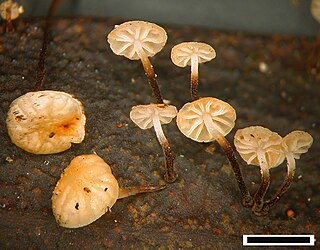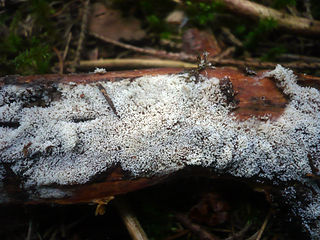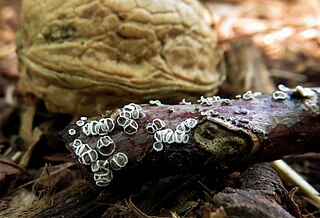
Amanita porphyria, also known as the grey veiled amanita or the porphyry amanita, is a fairly common, inedible mushroom of the genus Amanita found in Europe and North America.

The Marasmiaceae are a family of fungi in the order Agaricales. Basidiocarps are most frequently agarics, but occasionally cyphelloid. According to a 2008 estimate, the family contained 54 genera and 1590 species, but molecular research, based on cladistic analysis of DNA sequences, has led to a more restricted family concept, so that the Marasmiaceae included just 13 genera, and some 1205 species. It was reduced further down in 2020, to 10 genera and about 700 species.

The Hygrophoraceae are a family of fungi in the order Agaricales. Originally conceived as containing white-spored, thick-gilled agarics, including Hygrophorus and Hygrocybe species, DNA evidence has extended the limits of the family, so it now contains not only agarics, but also basidiolichens and corticioid fungi. Species are thus diverse and are variously ectomycorrhizal, lichenized, associated with mosses, or saprotrophic. The family contains 34 genera and over 1000 species. None is of any great economic importance, though fruit bodies of some Hygrocybe and Hygrophorus species are considered edible and may be collected for sale in local markets.

Collybia is a genus of mushrooms in the family Tricholomataceae. The genus has a widespread but rare distribution in northern temperate areas, and contains three species that grow on the decomposing remains of other mushrooms.
Palaeocephala is a genus of fungi. This is a monotypic genus, containing the single species Palaeocephala cymatelloides, described by Rolf Singer in 1962. According to the Dictionary of the Fungi, the genus is classified in either the Marasmiaceae or Physalacriaceae families; the taxonomical database MycoBank includes it in the Marasmiaceae.
Calathella is a genus of fungi in the mushroom family Marasmiaceae. According to the Dictionary of the Fungi, the genus contains nine species found in Europe and North America. The genus was circumscribed by the English mycologist Derek Reid in 1964.
Cymatellopsis is a genus of fungus in the mushroom family Marasmiaceae. This is a monotypic genus, containing the single species Cymatellopsis ilmiana, found in east Africa.
Fissolimbus is a fungal genus in the family Marasmiaceae. This is a monotypic genus, containing the single species Fissolimbus fallaciosus, found in Papua New Guinea. The genus and species were described as new to science in 1979.

Gloiocephala is a genus of fungi in the family Physalacriaceae. The genus is widespread, though mainly known from tropical and sub-tropical areas, and contains about 30 species.

Moniliophthora is a genus of fungi in the family Marasmiaceae. The genus was described in 1978 with M. roreri as the type species. This fungus, formerly known as Monilia roreri, causes frosty pod rot, a serious disease of Theobroma cacao.
Phaeodepas is a genus of fungus in the family Marasmiaceae. The genus contains two species found in Venezuela.

Rectipilus is a genus of cyphelloid fungi in the family Marasmiaceae. The widespread genus contains nine species. It was circumscribed by Reinhard Agerer in 1973.
Stromatocyphella is a genus of fungus in the family Marasmiaceae. The genus contains three species found in North America.

Lachnella is a genus of cyphelloid fungi in the Niaceae family. The genus has a widespread distribution and contains six species.

The cyphelloid fungi are a group of fungi in the Basidiomycota that have disc-, tube-, or cup-shaped basidiocarps, resembling species of discomycetes in the Ascomycota. They were originally referred to the genus Cyphella and subsequently to the family Cyphellaceae, but are now known to be much more diverse and are spread through several different genera and families. Since they are often studied as a group, it is convenient to call them by the informal (non-taxonomic) name of "cyphelloid fungi". Better known cyphelloid genera include Calyptella, with stalked, cup- or bell-like fruit bodies; Lachnella, with conspicuous, hairy-margined, disc-like fruit bodies; Flagelloscypha with smaller, but equally hairy, cup-like fruit bodies; Henningsomyces with tube-like fruit bodies; and Merismodes with clustered, hairy, cup-like fruit bodies.

Agaricus silvaticus, otherwise known as the scaly wood mushroom, blushing wood mushroom, or pinewood mushroom, is a species of mushroom often found in groups in coniferous forests from early summer, or September through to November in Europe, North Africa and North America.

Lepiota clypeolaria, commonly known as the shield dapperling or the shaggy-stalked Lepiota, is a common mushroom in the genus Lepiota. It is widely distributed in northern temperate zones, where it grows in deciduous and coniferous forest. Fruit bodies have a brownish cap, a shaggy stipe with a collapsed, sheathing ring or ring zone, and spindle-shaped spores.

Marasmius siccus, or orange pinwheel, is a small orange mushroom in the Marasmius genus, with a "beach umbrella"-shaped cap. The tough shiny bare stem is pale at the top but reddish brown below, and the gills are whitish. The stem is 3–7 centimetres (1.2–2.8 in) tall and the cap is 0.5–2.5 centimetres (0.20–0.98 in) wide.

Inosperma is a genus of gilled mushroom in the family Inocybaceae. Previously defined as a subgenus within the large genus Inocybe by Robert Kühner in 1980, these fungi were found to be more distantly related in a 2019 multigene phylogenetic study by Matheny and colleagues.













